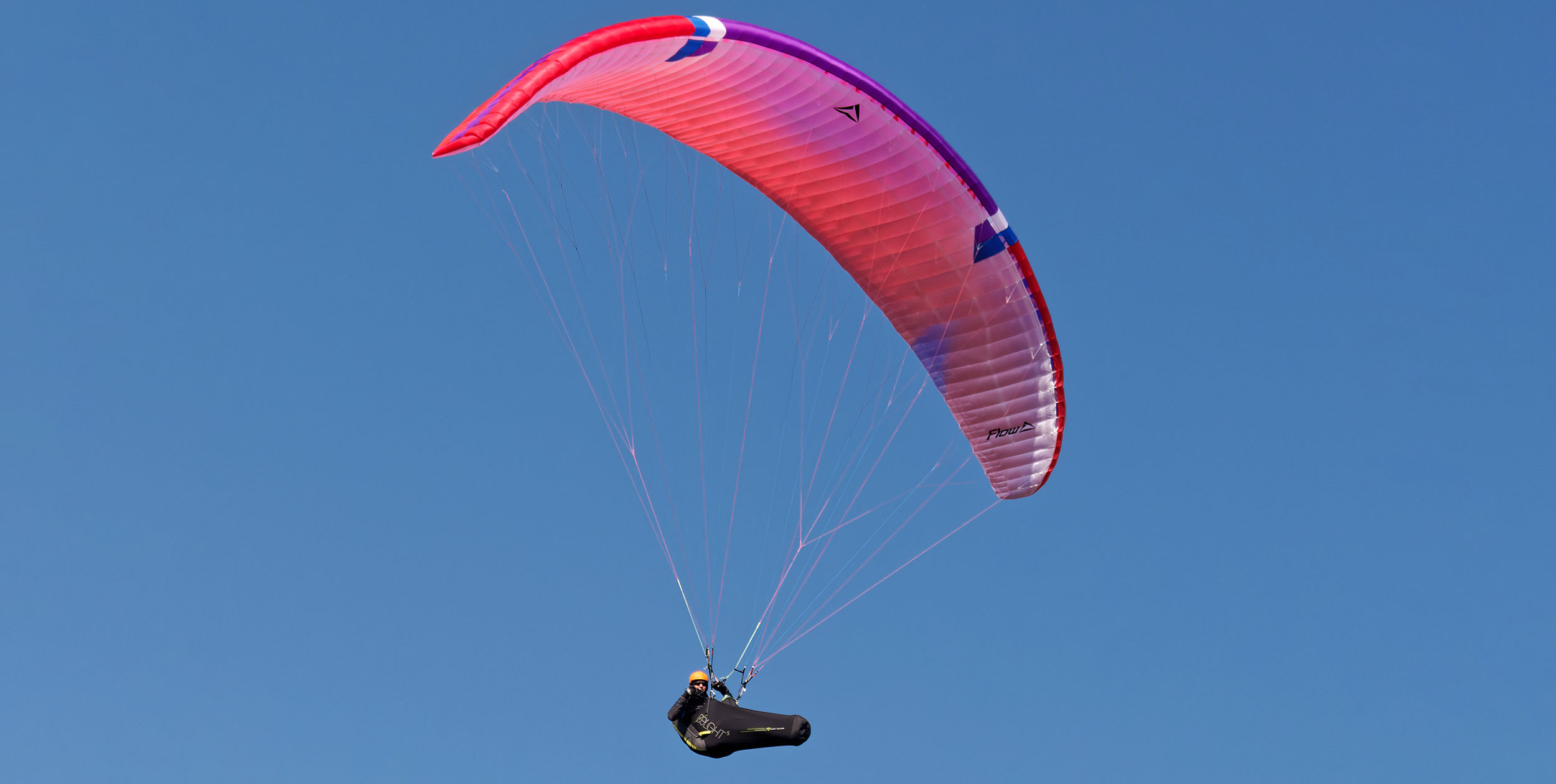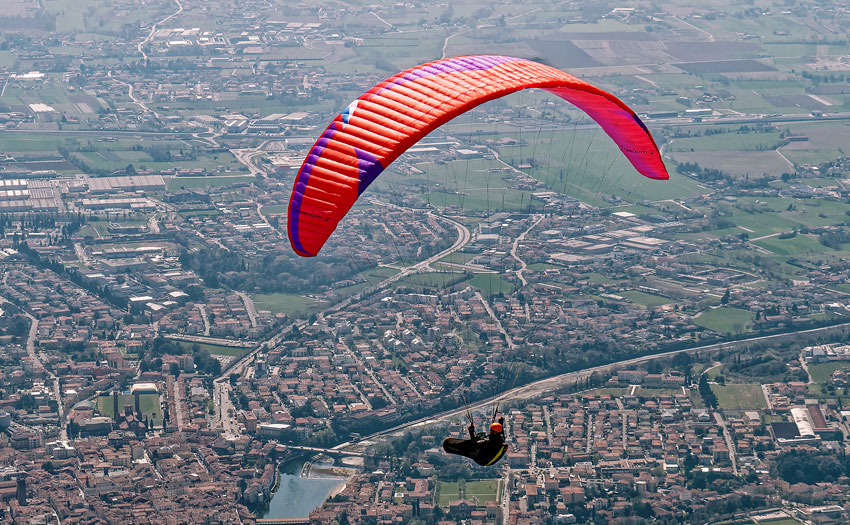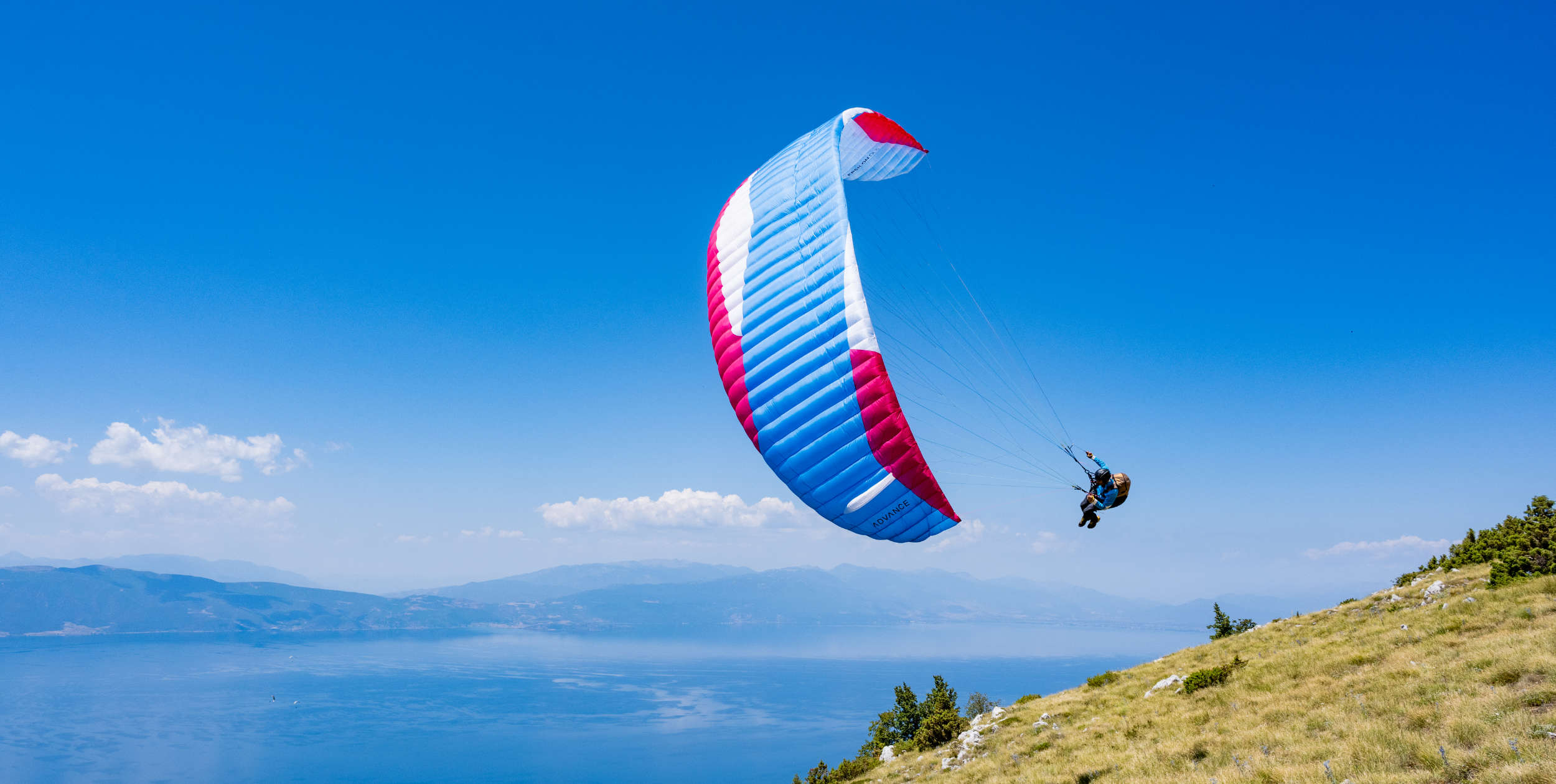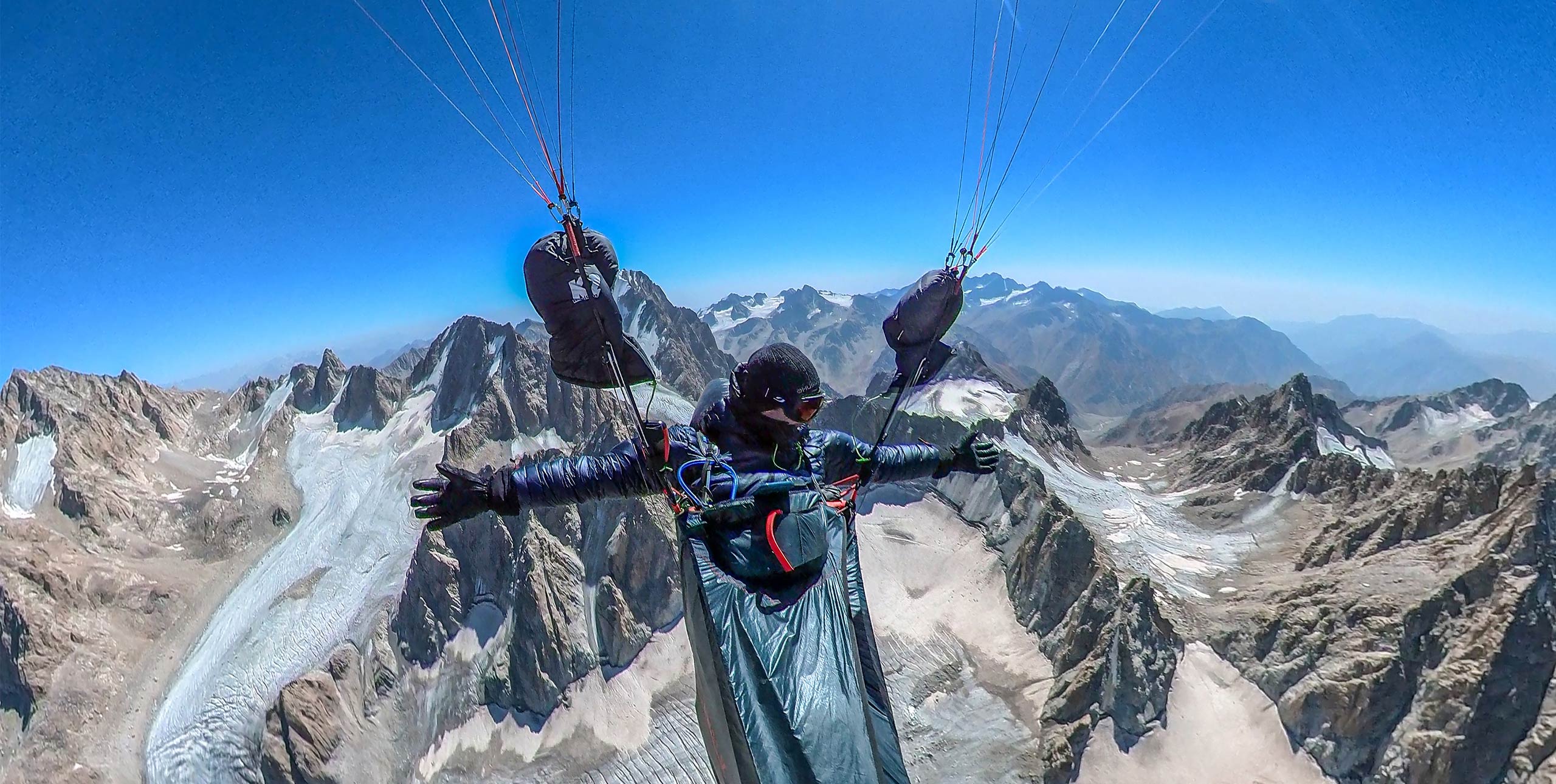
Ed Ewing jumps onboard the freedom train to fly this EN-B 3/2-line XC glider.
Flow have not had an easy time of it since deciding to “go global” at the start of 2018. Set up by Brazilian/Australian designer Felipe Rezende, Flow’s first wing was the Yoti, a mini-wing launched in 2016. At the time Felipe was still funding paraglider design and development from his day job working in surfing and kitesurfing.
Architecture training, a love for “flow” sports (swimming, surfing, kiting, free flight) and an understanding of fluid dynamics led him to start toying with designing paragliders in the early 2010s, until eventually he bit the bullet and formally set up Flow Paragliders – the “first Australian paraglider manufacturer”.
After the Yoti, Flow released the XC Racer (EN D) and Spectra (CCC), before releasing the Fusion (EN C) and the Freedom (EN B). Felipe had a reason for doing it that way: he wanted to experiment with high-end gliders first so he could put what he learnt into his intermediate and sports class gliders.
Two years after Felipe went full time with Flow however, the pandemic happened. After that, just as he was about to get going again and launch this glider, the Freedom 2, he had to change manufacturers from Thailand to Sri Lanka – something that turned out to be a torturous, lengthy and expensive process.
I mention all this back-story about Felipe because, like many of the smaller designer-owner brands in our sport, he is the brand. What you fly is a wing full of his ideas, knowledge, experience and passion. Knowing about the designer will help you understand the wing. (Gavin McClurg’s interview with him from 2018 on Cloudbase Mayhem is well worth a listen.)

Out of the box
I had meant to take the Freedom 2 to Colombia but plans changed. So instead my first flight was on a cold, early winter’s day on the coast. No one else had their glider out as it was windy, but knowing the site I thought “Top end but fair” and unpacked.
The glider is a 3/2-line design (Felipe was the first designer to make a hybrid 3/2 line wing – on the Fusion in Jan 2020) made of 32g Porcher material with more robust 38g on the leading edge. The aspect ratio is 5.75 (for comparison, the Nova Mentor 7 is 5.5, Advance Iota DLS is 5.6 and Ozone Rush 6 is 5.7, all high-B cross-country gliders) and there are 60 cells. I was flying the L (105-122kg), one of four sizes.

Noting that the lines were easy to handle and all sheathed and the risers were colour-coded and standard 12mm webbing I built a wall and got ready for a bit of excitement. Unfortunately no one had told the Freedom 2, and so it just sat there happily on the ground, under control, no bobbing up and down, no tips snaking, just waiting. Hmm I thought. I better do an A&Cs launch, to control the wing as it is sure to rise fast and shoot. A “waiting and watching” pilot on my left encouraged me to be ready to take “full control”.
Doing just that I pulled the wing up, it rose beautifully, did not overshoot, sat into wind, allowed me time to turn around, and then lifted off as I pushed forwards. I can honestly say I don’t think I’ve ever experienced such an easy strong-wind take-off. Knowing Felipe and Flow’s background in mini-wings and kites and that they live and fly every day on the NSW coast in Australia, this is certainly by design and very clever.

In the air
Having launched into smooth coastal air I was expecting a smooth ride, exploring the glider’s speed and rear-riser control system. It was not so long ago that rear-riser control systems on EN B gliders were there almost for show – they pulled at the trailing edge but did not change the angle of attack.
With the 3/2-line hybrid design this is not the case, and the rear-riser control is a genuine tool, allowing you to fly the glider on its rear risers while on bar and also for (a bit of) direction while off bar. (You use the brakes when thermalling – I just mean you can guide the glider’s direction by using its rear risers when cruising about.)
However, flying hands-up I could immediately feel a definite mix of yaw and roll, more than other gliders of this class I have flown recently. Hands off, smooth air, straight line, and the glider was working away above me. This stayed with me throughout the review period, and while it did not really affect the flying I did, it did take me time to manage it (lots of wrap/half-wrap/wrap going on).
After filming the wing with a 360 camera to make sure I was not going mad, scouring the manual and reading other reports and reviews I finally asked Felipe Rezende about it by email. Quick to reply and reassure, he said that actually yes, “the early production gliders had a high angle of attack on the two-liner section of the wing (wingtip section) which might explain the yaw/roll you are referring to.” Slow tips would make the tips “fight” with each other, he said, and that was what I was feeling.
He added: “Since the early production models we have adjusted the trim speed of the tips. The handling is much improved and it carves up nicer in turns and adds more washout, which translates to more optimised aerodynamics and consequently better performance.” That was good to hear. Now, onto the rest of the review and the glider’s many other good points.

Spring thermals
As well as the washout in the wingtips that Felipe mentioned, the wing is packed with interesting design features. The hybrid line layout, sharknose, 3D shaping and sail tensioning, a “racing arc” (at least three pilots said “It looks like a C glider”), colour choices which include “Disco Yellow” (here is my credit card), and a four-way attachment system for the A-lines.
This last element is clever and, according to Flow, helps make the leading edge more stable when on bar. “The four-line split mimics the same solution given to higher-end gliders where the A-attachment points are placed further back, which results in a stronger and more collapse-resistant leading edge in low angles of attack.”

Forward launching into early spring conditions in Bassano (perfect launch behaviour every time) I enjoyed a three-hour 45km out-and-return along the ridge in strong (5m/s) and quite windy conditions (12km/h). While the air was sporting and the pilot a bit over-wintered, the glider behaved impeccably. I got zero collapses all week.
On three-quarter bar on crossings and coming back into wind I felt only confidence – newer pilots will not know that not so long ago we used to feel nervous fear when pushing bar to get through compression and round the corner when flying spur-to-spur, just waiting for a blowout. Now we just push, speed up and make it round while WhatsApping (only joking). In later tests full bar added 10km/h GPS speed to trim.
On a lighter, overcast day I found myself scratching in close to cliffs and forest under a cap of grey cloud. Soaring around the back of bowls and working tight climbs with limited headroom was the game – and was super fun. The glider responded well to all conditions, from nil-wind launches to XC.

The verdict
The glider is a true high-B. It has good performance in the air, straightforward handling on the ground, and a high degree of passive safety while still being fun to fly. You can bank it up, fly it flat, push the bar and rock along the ridge on your rear risers. You must fly actively, it is not for beginners, but for solid intermediate pilots out to fly 50, 60, 70, 100km, it’s going to help you do that.
I was left with a great feeling of respect for Felipe as a designer. This is only the second high-EN B he has released and if this was wine I would be telling you I could feel the notes of the strong Australian see breeze, thermic testing days in Manilla, his architect’s brain, competition heart and surfer’s sensibility. I think he – and Flow – probably do have a game plan to “go global”. There are 62 dealers listed on Flow’s website, which means this Australian brand is out to conquer the world, and that’s admirable. Felipe, the whole team, are doing what they love, and that shows in their wings.
Manufacturer’s SPECIFICATIONS
Flow say: “Freedom 2 has a true racing pedigree with awesome handling and agility. It’s also an incredibly fun wing to fly”
Use: XC
Pilot level: intermediate and above
Sizes: XS, S, M, L
Flat area (m2): 22.4, 24, 26, 27.6
Take-off (kg): 60-80, 70-95, 85-108, 105-122
Weight (kg): 4.5, 4.75, 4.9, 5.2
Cells: 60
Flat aspect ratio: 5.75
Certification: EN B
Published in Cross Country 240 (June 2023)











